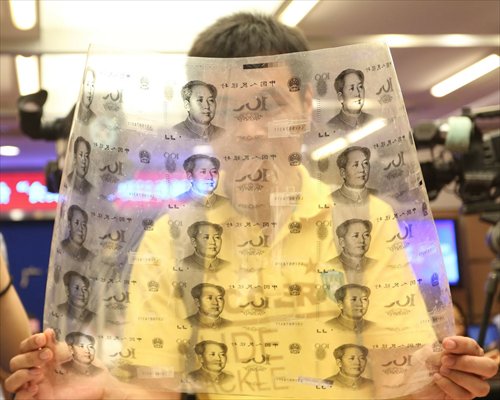HOME >> CHINA
Security forces up their efforts to find fake money
Source:Xinhua-Global Times Published: 2015-3-19 20:33:01

A film that criminals used to make fake money is displayed at a police bureau on July 30, 2014 in Guangzhou, Guangdong Province. Photo: CFP
Many find it difficult to tell a counterfeit bank note from a genuine one. Most often, a portrait of the late State leader Mao Zedong, a few words in ethnic minority languages, a safety line and a watermark are all it takes to fool the untrained eye.
And because the technology used to produce counterfeit money has improved in recent years, it is more difficult than ever to spot a fake. Some of the fake cash can even pass through a bank clerk's currency detector without getting caught.
However, there is no counterfeit currency so convincing that it fools the special police squad tasked with fighting the forgers.
In order to identify counterfeit money, find out where it comes from and how it is produced, China's first anti-counterfeit money laboratory was set up by the Ministry of Public Security (MPS) in 2011. The latest lab was built in Tianjin in December 2014, making it the third anti-counterfeit money laboratory in China.
During a recent media visit to an anti-counterfeiting laboratory, a Xinhua News Agency reporter learned how to identify fake notes by checking the subtle differences in design and color tone between real and forged bills. Counterfeit bills are often duller in color while the shape of the denomination, the portrait of Mao and the safety line may look blurry.
Forgery on the rise
Dong Yongxian, the head of the laboratory, explained that the process used to counterfeit money is highly complicated.
Criminals first purchase paper, iron on a safety line and then print colors onto it layer by layer. After that, they re-size the paper and process it again to fine tune the details. Every counterfeit note is also compressed in order to create a textured finish, he said, adding that a forger has to be very careful when producing counterfeit notes because a minor mistake could ruin the product.
"If the counterfeit money is produced carefully, the profit it makes can be enormous," Dong said. "In a counterfeit case which involved 220 million yuan ($35.4 million) in Guangdong Province late last year, we found that the criminals could make tons of counterfeit money worth 100 million yuan within a week if they worked 24/7."
According to Xinhua, the Chinese public security authorities have uncovered over 1,000 cases related to counterfeit money in the past few years. The amount of counterfeit money seized in 2014 was 25 percent larger than that seized in 2012.
Criminal innovations
"With bank notes, we will analyze the fiber, the type of wood used and the water content to identify the origin of the money, which helps police find the location of the factory," Dong said.
According to analysis conducted on counterfeit bank notes found over the past few years, 96.7 percent of the money was made from moulds designed by the one man, named Peng Daxiang.
Peng, who is over 70 years old, is a painter in Guangdong. He is so skillful that he was able to create a series of highly accurate renminbi moulds without using a computer. A 100 yuan renminbi mould he made could be sold for anywhere between a few thousand yuan to a few hundred thousand yuan.
"Peng was sentenced to life imprisonment in 2003 after police uncovered a counterfeit money case in January that year, but his moulds and the counterfeit money made from the moulds are still in the market currently," Dong noted.
Apart from Peng's counterfeit money, analyst found that the techniques used to produce ersatz bank notes have evolved a lot in recent years, making it harder for the police to clamp down on such activities.
Pan Yuzong, director of the economic crime investigation department of the MPS, said the denominations of the counterfeit money produced is getting smaller, and the number of counterfeit one yuan, five yuan and 10 yuan notes in circulation has rocketed.
"Since people do not pay much attention to such low-value cash, the money is spread widely, harming the general public," Pan said, adding that a group of people in Shandong Province, who were arrested in February, produced 160,000 yuan worth of counterfeit one yuan coins.
Also, with the help of the Internet, criminals can sell and transport their fake notes faster and more easily than before, making it more difficult for police to discover and trace them.
"Surprisingly, some people even openly sell counterfeit money on the Internet," he said.
Hardware developments have also contributed to the changing nature of the crime. In the past, if one wanted to produce counterfeit money one needed a number of specialized machines such as a printing press, a paper cutting machine and a film machine. But nowadays, all that is needed to create basic counterfeit money is a printer, ink and paper.
Anti-counterfeiting collaboration
The counterfeit money found over the past years was mainly produced in Guangdong, but counterfeit money factories are increasingly found in other parts of the country.
So far, the anti-counterfeit money task force has set up 13 monitoring points all over China to crack down on the spread of counterfeit money.
Dong said the laboratory will work on several anti-counterfeit money mechanisms such as collaborating with banks to help them identify fake bank notes and will work closely with other countries to exchange information and monitor current forgery trends.
In 2014, a new kind of counterfeit money was found in circulation with serial numbers starting with "30."
"The rise of new kinds of counterfeit money shows that counterfeit money production sites are spreading," Pan said.
He remarked that this year the MPS will work closely with the People's Bank of China to target specific regions to further suppress counterfeit money crimes.
Newspaper headline: Counterfeiting clampdown
Posted in: Society